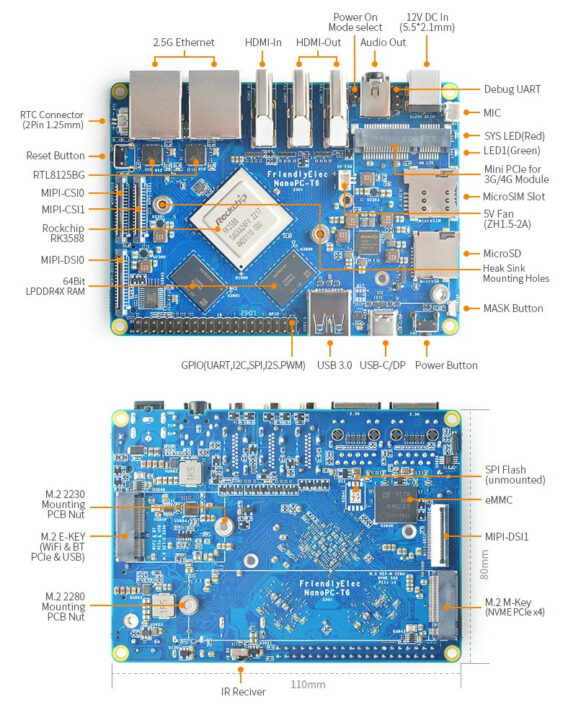FriendlyELEC NanoPC-T6 is a feature-rich Rockchip RK3588 SBC with up to 16GB LPDDR4X RAM, 256GB eMMC flash, two HDMI 2.1 output ports, one HDMI 2.0 input port, dual 2.5GbE, two M.2 PCIe socket for storage or wireless, a mini PCIe socket and microSIM slot for 4G LTE connectivity, and more.
The new NanoPC-T6 single board computer offered many more interfaces than the recent NanoPi R6S or R6C board based on the Rockchip RK3588S with fewer I/Os. As such, it would be suitable for a wider range of applications and FriendlyELEC says it is well suited to enterprise consumers who want to develop mini machine vision systems, and embedded systems hobbyists who want to explore and implement all sorts of prototypes.
NanoPC-T6 specifications:
- SoC – Rockchip RK3588
- CPU – Octa-core processor with 4x Cortex-A76 cores @ up to 2.4 GHz, 4x Cortex-A55 cores @ 1.8 GHz
- GPU – Arm Mali-G610 MP4 GPU with support for OpenGL ES 1.1, 2.0, and 3.2, OpenCL up to 2.2, and Vulkan 1.2
- AI accelerator – 6 TOPS NPU
- VPU – 8Kp60 H.265/VP9/AVS2 10-bit decoder, 8Kp30 H.264 decoder, 4Kp60 AV1 decoder, 8Kp30 H.265/H.264 encoder,
- System Memory – 64-bit 4GB, 8GB, or 16GB LPDDR4X at 2133MHz
- Storage
- 32GB, 64GB, or 256GB eMMC flash (HS400 mode)
- M.2 NVMe 2280 SSD socket
- MicroSD card slot up to SDR104 mode
- Footprint for SPI flash, useful for network boot
- Video
- Output
- 2x HDMI 2.1 ports one up to 8Kp60, the other up to 4Kp60
- 2x 4-lane MIPI-DSI up to 2560×1600 @ 60 Hz compatible with MIPI DPHY 2.0 or CPHY 1.1
- 1x USB-C (DisplayPort 1.4) up to 4Kp30
- Input
- 1x HDMI 2.0 input port up to 4Kp60
- 2x 4-lane MIPI-CSI compatible with MIPI V1.2
- Output
- Audio
- 3.5mm stereo audio jack (ALC5616)
- Digital audio via HDMI or DisplayPort
- 2.0mm PH-2A connector for analog microphone input
- Networking
- 2x 2.5GbE RJ45 ports via Realtek RTL8125BG controllers
- Optional WiFi and Bluetooth via M.2 module
- Optional 4G LTE connectivity via mPCIe module + microSIM card slot
- 2x 2.5GbE RJ45 ports via Realtek RTL8125BG controllers
- USB – 1x USB 3.0 Type-A port, 1x USB 3.0 Type-C port with support for DisplayPort Alt. mode up
- Expansion
- 40-pin GPIO header with up to 28x GPIOs, 6x UART, 1x I2C, 2x SPI, 8x PWM, 2x I2S
- M.2 Key-M socket with PCIe 3.0 x4 (typically used with an NVMe SSD)
- M.2 Key-E socket with PCIe 2.1 x1 and USB 2.0 host (typically used with a wireless module)
- mini PCIe socket and microSIM slot for cellular connectivity
- Misc
- Power, MASK (for eMMC update), and Reset buttons
- 2-pin connector for battery for the HYM8563TS RTC
- 5V fan connector
- 2x user LEDs
- 1x IR receiver
- Power on mode select jumper
- 3-pin 3.3V debug header (1,500,000 bps in firmware)
- Power Supply – 12V/2A via DC jack (5.5×2.1mm)
- Dimensions – 110 x 80 mm (8-layer PCB); mounting holes for heatsink; mounting holes in all four corner
- Weight – 85.9 grams
- Temperature Range – 0°C to +70°C
The NanoPC-T6 is like a more compact version of the Banana Pi BPI-W3 SBC, albeit with some differences like dual 2.5GbE and extra M.2 socket, but no support for USB PD and PoE. The documentation is also much better with detailed hardware information and instructions for the Android 12, Ubuntu 20.04/22.04, Debian 11, and OpenWrt-based FriendlyWrt images provided for the board.
While you could install a heatsink by yourself, FriendlyELEC has also made an aluminum case measuring 114.5 x 86 x 30mm and weighing 394 grams with the board. The company’s own test shows the CPU temperature did not exceed around 62°C under load, against about 69°C with the NanoPi R6S in its own metal case. I suppose getting a larger board and enclosure does help with cooling. The NanoPC-T6 does throttle to 1400-1600 MHz without any cooling, so if you don’t get the metal enclosure, a heatsink is recommended.

The NanoPC-T6 starts at $100 on FriendlyELEC’s store with 4GB RAM and a 32GB eMMC flash. The 8GB/64GB model goes for $120 and the 16GB/256GB variant for $149. The metal enclosure adds $20, and other optional accessories include an $18 M.2 WiFi card based on Realtek RTL8822CE (WiFi 5 up to 867 Mbps and Bluetooth 5.0), a $2.90 RC-100 IR controller, and a $9.89 12V/2A power adapter.

Jean-Luc started CNX Software in 2010 as a part-time endeavor, before quitting his job as a software engineering manager, and starting to write daily news, and reviews full time later in 2011.
Support CNX Software! Donate via cryptocurrencies, become a Patron on Patreon, or purchase goods on Amazon or Aliexpress






